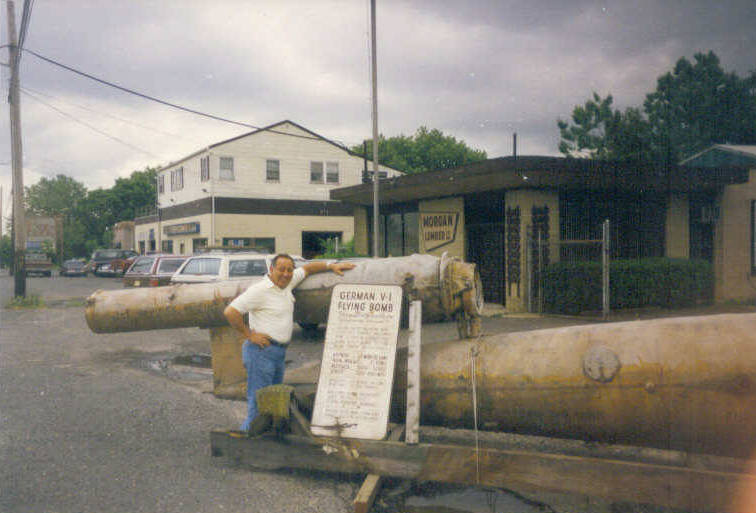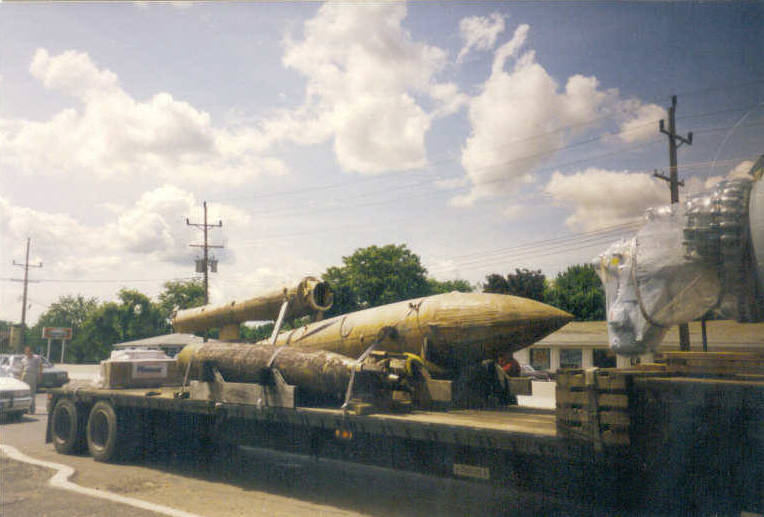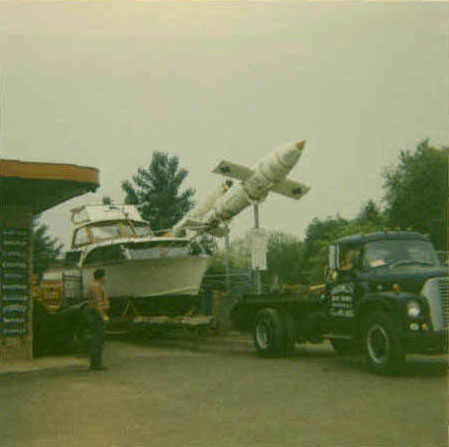Morgan Memories – Morgan Lumber’s German V-1 “Buzz” Bomb
Curiosity finally got the better of me regarding an unusual artifact which used to be prominently displayed at Morgan Lumber on Route 35. When Christina DiPoalo Olender, daughter of Morgan Lumber founder and co-owner John DiPoalo, responded to a Facebook inquiry, she was kind enough to answer one of my long wondered about questions.
While many may mostly remember the large stack of boat cradles that lined the lumber yard (see the photo on this page) – I know I certainly do – if they had looked closer, they would have seen the unusual rocket that was perched on top of poles alongside the Morgan Lumber office. Mr. John DiPoalo, a WWII veteran who was one of the amazing young men that landed in France during the Normandy Beach invasions, was visiting a salvage yard one day in the 1950’s or 1960’s when he saw a very familiar shape under a tarp in the corner of the yard. His hunch was confirmed when the tarp was removed. Low and behold, under the tarp was a World War II era German V-1 “Buzz Bomb”, one of Germany’s many advanced innovations of the war. Having had a huge interest in weaponry all of his life – per Christina he always spoke about the topic – Mr. DiPoalo acquired the flying bomb (sans explosive charge), refurbished it and prominently displayed it in his lumber yard. Obviously it made a huge impression on at least one snotty nosed kid from Morgan.
During World War II on 13 June 1944, just a few days after John DiPoalo landed in France, the German Air Force (Luftwaffe) launched the first V-1s against London, England from launch sites on the coast of France. From this date until the last one was launched on 30 March 1945, the Germans launched over 8,500 V-1s against London or Antwerp, Belgium. The accuracy of the V-1 was very bad, with only about half of the total missiles launched landing within 8 miles of their targets if they had not been shot down, flipped over by aircraft or snagged by barrage balloon wires. The first V-1 to reach London killed eight civilians, injured 30 and made 200 homeless when it blew up on Grove Road next to a railway bridge. Today there is a plaque on the railroad bridge’s brick wall at this location which is four miles north east of the Houses of Parliament and 2.5 miles northwest of the Millennium Dome.

Mr. Danny DiPoalo, Morgan Lumber Co-Owner, with the Morgan Lumber Buzz Bomb in 1992. Photo Courtesy of Christina DiPoalo Olender.
Shortly after the Buzz Bombs rained down on London, the US acquired some of the parts of the crashed Buzz Bombs and shipped them back to Wright Field in Dayton, Ohio to be reverse engineered. Republic Aviation Corporation was contracted to build the US version, named the JB-2 “Loon”, with Ford Motor Company building the engine. “JB” most likely stands for “Jet Bomb”. The JB-2 was one of the weapons intended to be used in the invasion of Japan planned to start on 1 November 1945. That invasion didn’t happen due to Japan’s surrender following the dropping of two atomic bombs on Japanese cities in August 1945.
A descendent of the German V-1 Buzz Bomb is the United States’ Tomahawk Cruise Missile (BGM-109: “B” Surface Attack, “G” Guided, “M” Missile). The Tomahawk was first used in combat by the US in the first Gulf War against Iraq on January 17, 1991. Like the V-1, the Tomahawk Cruise Missile is an unpiloted flying bomb. In the decades since 1944 when the V-1 was first used, many technologies have advanced allowing for the accuracy of Tomahawk Cruise Missiles to be nothing short of amazing and orders of magnitude more accurate than the V-1. When I worked on the Cruise Missile project during its research and development stage in the early 1980’s, it was supposed to be able to fly an unspecified number of miles (hundreds) then fly between the goal posts of a distant football field. This was before the GPS Global Positioning System was operational. With the advent of GPS, it would only have become more accurate.
When you work on advanced technology projects, you sometimes wonder if what you are working on will really ever be able to do what it is supposed to be able to do. Clearly in this case, it did and still does.
During the time he owned it, John DiPoalo learned the Morgan Lumber V-1 was only one of 23 V-1s known to still exist out of the nearly 30,000 made. In July 1992, he donated the Morgan Lumber V-1 to the United States Air Force Museum in Dayton, Ohio. Interestingly enough, this is same place where the crashed Buzz Bomb parts were sent in 1944.

Morgan Lumber’s V-1 Buzz Bomb and a World War II Paravane (Underwater Glider Used to Sweep Mines) Leaving Morgan Forever, with Stewart’s Root Beer in the Background in 1992. Photo Courtesy of Christina DiPoalo Olender.
V-1 Technical Information (information varies according to source):
Name: Vergeltungswaffe or “Retaliation or Vengeance Weapon”
Nicknames: “Doodlebug” or “Buzz Bomb”
Designation: Flak-Ziel-Gerät (antiaircraft target) FZG-76
Armament: 2,100-lb. high-explosive warhead (Amatol-29)
Manufacturer: Gerhard Fieseler Werke (Fieseler)
Engine Type: Pulse-jet (50 times per second)
Targets:London, England and Antwerp, Belgium
Operating speed: 375-400 mph
Range: 150 miles – ironically the exact distance from London to the Normandy Beaches where the Allied Armed Forces landed on D-Day.
Operating altitude: 2,000-4,000 ft.
Average Flight Time: 22 minutes
Span: 17 ft. 6 in.
Length: 27 ft. 3 3/4 in. (varies depending on the information source)
Height: 4 ft. 8 in.
Weight: 4,753 lbs., 5,023 lbs. loaded
Duration of Use: 13 June 1944 and 29 March 1945
London Casualties: More than 6,000 people died, over 18,000 were wounded
Launch System: Steam powered catapult on a 200-foot inclined ramp
Location of Launch Sites Against London: French coast
Frequency of Launch from One Launch Ramp: One V-1 launch per hour
Guidance System: Magnetic compasses, a timer and a system of gyroscopes guided Buzz Bombs along a preset course and distance.
Weapon Arming Sequence: When the weapon was in the target’s approximate position, the warhead was automatically armed and the aircraft put into a steep dive. This stopped the fuel from flowing to the engine causing it to shut off. The bomb would then free-fall and explode on impact.
Reason for “Buzz Bomb” Nickname: Pulse-jet engine made a distinctive buzzing noise as the louvers would rapidly open and shut in coordination with the igniting fuel.
Click here to access detailed V-1 photos, drawings, descriptions, documents and sounds.
Click here to see a video describing the V-1. You need to understand German if you also want to listen to it.
Click here to see a video explaining how pulse jets work.
Click here to see a video showing a pulse jet demonstration.
Originally posted on February 1, 2010.


I asked if anyone recalled the V1 in another comment before I read this page. We moved from Morgan in November 1958 and it was there while we lived there.
as a kid my father used to take us to Jones Beach an sea cliff I remember seeing it on one of our trips we always went thru Mineola an there were still dirt roads Gruman aircraft ,all gone!